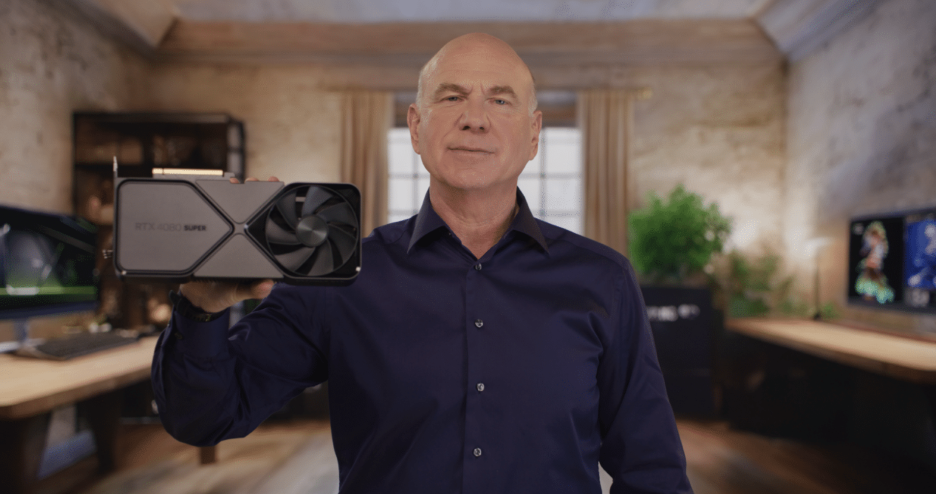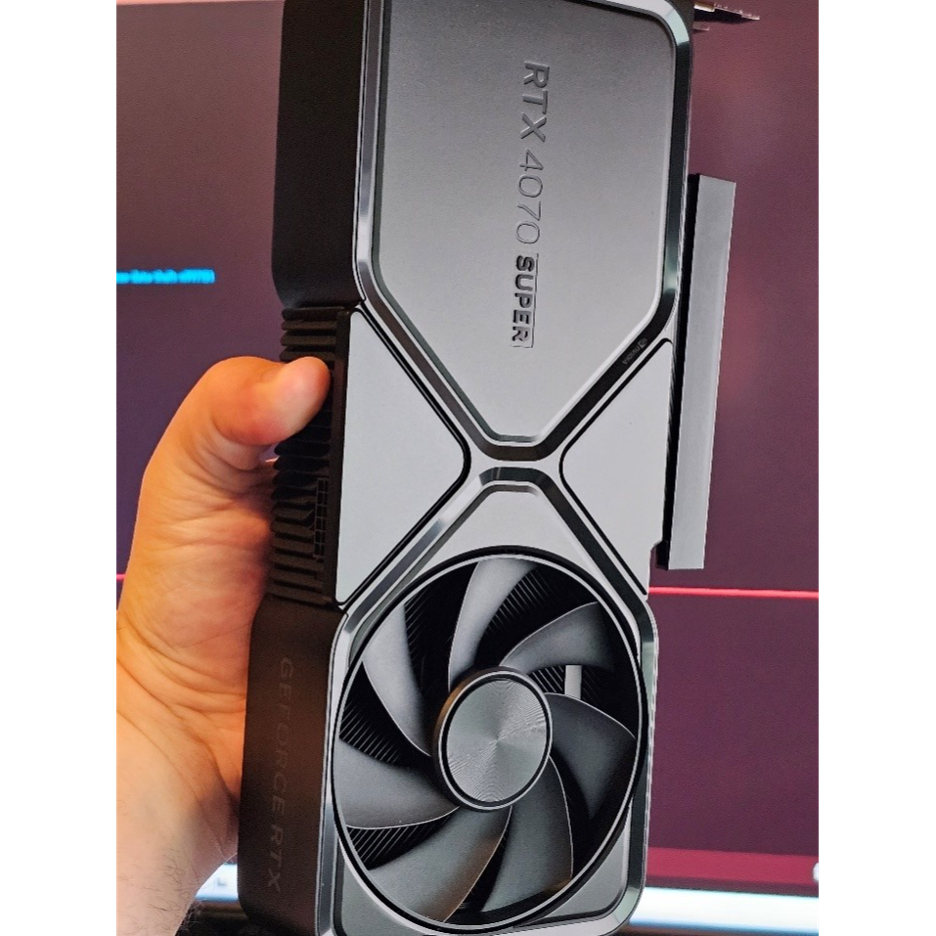
NVIDIA is usually one of the first companies to hold a launch event at CES, and this year was no different, with its special address happening bright and early at 8 a.m. on the first day. The company led by reviewing its pedigree in AI and general-purpose GPU computing, going back to the 8800 GTX, which was released in 2006—around the same time I began my tech career. In fact, I have witnessed NVIDIA’s rise in the GPU and AI spaces since the first GTC conference hosted in what is now the Signia by Hilton in San Jose.
This year, NVIDIA is heavily pushing how AI enhances the gaming experience on-device, in the cloud, and even in some hybrid scenarios. Naturally, most of NVIDIA’s approaches incorporate its own GPUs, so its perspective is focused less on NPUs and more on GPUs and its CUDA toolkit.
New Super GPUs
At CES 2024, NVIDIA announced three new GPUs in its lineup. The company chose to refresh the RTX 4080, 4070 Ti, and 4070 with the “Super” designation, which usually represents minor tweaks to the GPU to enable slightly faster performance. Usually, the Super series replaces its predecessors, and this was mostly true this time, except for the RTX 4070, which will live alongside the RTX 4070 Super for now. There are also some major changes with the RTX 4070 Ti Super, with NVIDIA moving that model to the AD103 GPU die from the AD104, which increases the transistor count to 45 billion from 35 billion. This means more cores across the board, including tensor, RT, and shader cores, which should provide a 5% to 10% performance increase, depending on the title. The 4070 Ti Super also increases memory bandwidth with a wider memory bus, going from 192 bits to 256 bits and from 12GB to 16GB of VRAM. All of this happens while keeping TDP the same and offering the GPU at the same MSRP price of $799. This translates to the 4070 Ti delivering more performance for the same price.

Meanwhile, the RTX 4070 made the most significant jump to the 4070 Super, with a 15% performance increase, which is big enough that NVIDIA believes both GPUs can coexist in the market. For me, the RTX 4070 was already the best-performance GPU in NVIDIA’s lineup for the money. The RTX 4070 Super now delivers 15% more frames for the same $599 price that the RTX 4070 launched with. The jump in price to the 4070 Ti at $799 was (and still is) considerable for marginally more performance. The RTX 4070 remains in the lineup at a reduced price of $549. I think there’s a chance that the RTX 4070 will go away over time, but right now, both the 4070 and 4070 Super will coexist.
The 4080 Super is a different value play with a $999 price, which is $200 lower than the launch price from 2022. The RTX 4080 uses the same AD103 chip as before but a newer stepping of that GPU with slightly more cores, bringing the theoretical max performance up to 52 TFLOPS from 48 TFLOPS. The base and boost clocks are slightly higher (2205 versus 2295 base; 2505 versus 2550 boost), which is why the expected percentage performance differences between the 4080 and 4080 Super are in the single digits. That said, if you are shopping for a new GPU, the value of the RTX 4080 has gone up in the RTX 4080 Super and is a less egregious price leap from the 4070 Ti/Super; the jump used to be from $800 to $1,200 and is now $800 to $1,000, which honestly seems more reasonable for the performance gains.
AI Features
NVIDIA also announced a slew of software features and tools that leverage the AI capabilities of NVIDIA’s GPUs both locally and in the cloud. First is NVIDIA ACE, for Avatar Cloud Engine, which enables game developers to leverage NVIDIA’s Audio2Face and NVIDIA Riva Automatic Speech Recognition. This feature takes advantage of both the user’s local GPU compute and the cloud, using a cloud inference server to generate an NPC LLM response, which then translates from text to speech and eventually gets sent back to the PC for rendering the audio to lip sync. NVIDIA has a long list of developers on board that are using ACE and its microservices in their games, including Charisma.AI, Convai, Inworld, miHoYo, NetEase Games, Ourpalm, Tencent, Ubisoft, and UneeQ.
In addition to ACE, NVIDIA introduced RTX Remix Open Beta, including a Half-Life 2 RTX trailer demonstrating the tool’s ability to remaster games with higher-resolution textures and ray tracing. The company has already remastered Portal with Portal: Prelude RTX; meanwhile, Orbifold Studios is leading Half-Life 2 RTX: An RTX Remix Project.
New G-Sync Features and Monitors
During the event, NVIDIA announced that there will be 24 new monitors with G-Sync, plus it introduced a new Pulsar feature. G-Sync Pulsar brings improved motion blur compensation to the variable refresh rate capabilities of G-Sync—which is G-Sync’s fundamental purpose. Before G-Sync, the industry didn’t emphasize enabling smooth frame rates through variable refresh rate, and Nvidia has paved the way in that effort.

G-Sync Pulsar seems like another way for NVIDIA to build a competitive moat around G-Sync to resist the advances of AMD’s FreeSync or Intel’s Smooth Sync. Pulsar allows users to have both ULMB (ultra-low motion blur)—enabling enhanced image sharpness—and variable refresh rates without compromise. Because Pulsar and many other premium G-Sync features still require NVIDIA hardware, I expect that we will see the company continue to push features like Pulsar to enhance the gaming experience and lock in users to G-Sync and GeForce. In addition to the lineup of 24 new monitors and Pulsar capabilities, G-Sync is finally coming to GeForce NOW. NVIDIA calls this Cloud G-Sync, and it will support variable refresh rates and G-Sync-compatible monitors.
RTX Games and more
NVIDIA announced that there have now been more than 500 RTX-enabled titles since its launch, which is impressive considering that NVIDIA has worked so hard for the last five years to make that possible. This time around, NVIDIA announced 14 new titles, including Horizon Forbidden West Complete Edition, Pax Dei, and Diablo IV, all leveraging the latest DLSS 3 with AI frame generation. Diablo IV is also coming to GeForce Now, as is Overwatch 2, thanks to the deepening Activision relationship.
NVIDIA is also adding day passes for GeForce Now, which is currently a monthly service but could represent an excellent avenue for NVIDIA to expand its customer base in the form of gamers who are super infrequent but want the flexibility and performance of GeForce Now. Passes start at $7.99 for the Ultimate tier and $3.99 for the Priority Tier. NVIDIA also works with Twitch and OBS to enable enhanced broadcasting with multi-encode streaming with three different resolutions simultaneously up to 1080p. In addition, with the RTX 40 series, Twitch and NVIDIA will enable 4K streaming using AV1, which is 40% more efficient than H.264, enabling higher-quality streaming experiences at much lower bit rates.
Wrapping up
CES 2024 has been quite a busy show already, and for NVIDIA it has come with a bevy of announcements across its different businesses. Of course, its gaming business routinely has the most announcements at a consumer show, but the company also has a lot going on in robotics and automotive. NVIDIA continues to push the innovations that set it apart from the competition, for example its RTX and G-Sync technologies.
We continue to see NVIDIA lean in on AI as the innovation accelerator, much like we have with DLSS 3 and AI frame generation and now with the commercialization of Audio2Face via ACE. I also believe that NVIDIA’s new Super series is a welcome addition to the GPU market and may leave some room for an RTX 4080 Ti based on current pricing. I already have the new RTX 4070 Super in hand and am excited to see it prove its value.






















































































